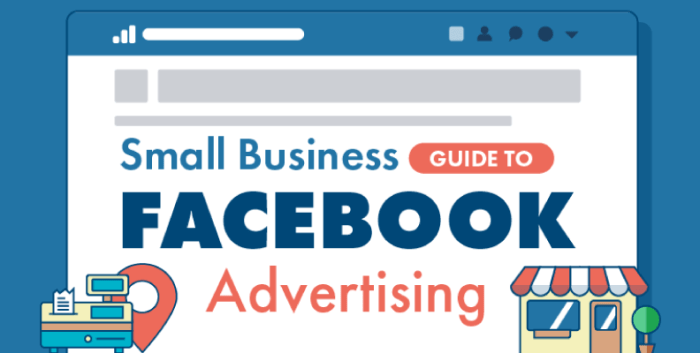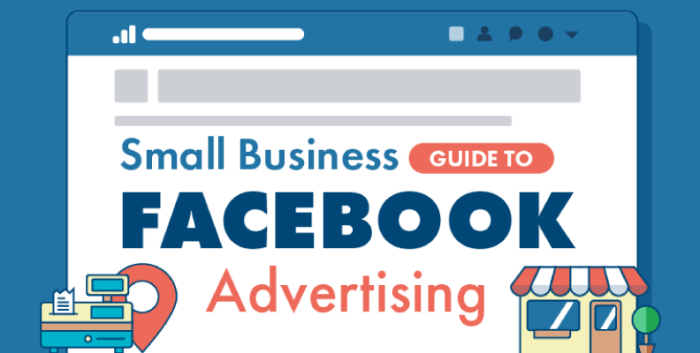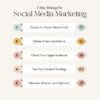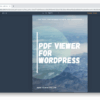Facebook advertising small businesses is crucial for growth in today’s digital landscape. This guide dives deep into strategies, from ad formats and targeting to budget management and A/B testing, empowering small business owners to maximize their Facebook ad campaigns and achieve impressive results.
We’ll explore various ad formats like image, video, and carousel ads, and how to use them effectively. Understanding your target audience is key, and we’ll cover how to leverage Facebook’s audience insights and targeting options to reach the right customers. We’ll also discuss essential budget management strategies and how to optimize ad spend for maximum return on investment (ROI).
Finally, we’ll highlight the importance of staying updated with Facebook’s policies and trends to navigate the ever-evolving advertising landscape.
Introduction to Facebook Advertising for Small Businesses
Facebook advertising offers a powerful, accessible platform for small businesses to connect with potential customers and grow their reach. It’s no longer just a social network; it’s a robust marketing tool, allowing businesses of all sizes to engage in targeted campaigns. This comprehensive guide explores the value of Facebook Ads for small businesses, highlighting their benefits, ad formats, and potential use cases.Small businesses often face challenges in reaching their target audience effectively and affordably.
Facebook advertising provides a solution, allowing for highly-targeted campaigns that can yield significant returns on investment. Leveraging Facebook’s extensive user base and sophisticated targeting options, small businesses can reach their ideal customers with precision.
Key Benefits of Facebook Ads for Small Businesses
Facebook advertising provides several key advantages for small businesses. These benefits include cost-effectiveness, precise targeting, and measurable results. Small businesses can reach a large audience without the significant investment required for traditional advertising methods.
- Cost-Effectiveness: Facebook Ads allow for a granular control over budget allocation, enabling small businesses to tailor their campaigns to fit their specific financial constraints. This flexibility makes it a highly cost-effective way to promote products and services, particularly when compared to other forms of marketing, such as print or television ads.
- Precise Targeting: Facebook’s extensive user data allows for extremely targeted advertising. Businesses can reach specific demographics, interests, behaviors, and even locations, ensuring that ads are seen by the most relevant audience.
- Measurable Results: Facebook Ads provide detailed analytics, allowing businesses to track campaign performance and measure return on investment (ROI). This data-driven approach enables businesses to optimize campaigns in real-time and refine their strategies for maximum effectiveness.
Ad Formats on Facebook
Facebook offers a diverse range of ad formats, each with its own strengths and use cases. These formats enable small businesses to adapt their messaging and visual appeal to different audiences and goals.
| Ad Format | Description | Use Case |
|---|---|---|
| Image Ad | A static image ad, typically used to highlight a product or service. | Promoting a new product launch, showcasing a special offer, or highlighting a company’s mission. |
| Video Ad | A short video ad, ideal for conveying a story or demonstrating a product’s functionality. | Explaining a product’s features, showcasing a brand story, or creating an emotional connection with customers. |
| Carousel Ad | A series of images or videos that users can swipe through. | Presenting multiple products or services, showcasing a variety of benefits, or guiding users through a multi-step process. |
| Collection Ad | Allows businesses to display multiple products or services in a visually appealing format, encouraging immediate purchase. | E-commerce businesses promoting product lines, retailers highlighting various products in a catalog, and showcasing different product variations. |
| Slideshow Ad | A series of images or videos playing automatically. | Creating a visually engaging experience for viewers, showcasing a brand’s aesthetic or highlighting multiple products. |
| Lead Generation Ad | Designed to collect leads directly from within the ad, streamlining the customer acquisition process. | Collecting contact information for email marketing, scheduling consultations, or creating sales funnels. |
Targeting Strategies for Small Businesses

Facebook advertising empowers small businesses to connect with their ideal customers. Effective targeting is crucial for maximizing ad spend and ROI. This involves understanding your audience’s demographics, interests, and behaviors to deliver highly relevant messages. By meticulously crafting your targeting strategies, you can ensure your ads reach the right people at the right time, leading to higher conversion rates and a stronger return on investment.Understanding your target audience is paramount.
Facebook advertising for small businesses can be tricky, but focusing on a “more we, less me” approach can really pay off. By shifting the emphasis from individual promotion to collaborative marketing efforts, you’ll find more success. This aligns perfectly with the philosophy of more we less me , which promotes collective growth over individual gain. Ultimately, this translates to better engagement and a more targeted audience, making Facebook ads more effective for your small business.
This isn’t just about knowing their age or location; it’s about uncovering their motivations, pain points, and aspirations. The more you understand their needs, the more effectively you can tailor your message and your ad campaign. This targeted approach, in turn, will increase the likelihood of engagement and ultimately drive sales.
Identifying Targeting Options on Facebook
Facebook offers a diverse array of targeting options, enabling businesses to precisely reach their ideal customers. These options span demographics, interests, behaviors, and more. The key is to combine these options strategically to create highly specific and effective ad campaigns.
- Demographic Targeting: This involves identifying your ideal customer based on factors such as age, gender, location, relationship status, education level, and job title. This allows you to focus your advertising efforts on the specific demographic groups most likely to be interested in your products or services. For example, if you’re selling children’s toys, targeting parents with children under 10 years old would be a more effective strategy than targeting adults.
- Interest-Based Targeting: Facebook allows you to target users based on their expressed interests, hobbies, and pages they follow. This is extremely valuable as it enables you to reach potential customers who are already interested in topics related to your business. For instance, if you’re a bakery, targeting people interested in baking, food, and desserts can yield a higher conversion rate.
- Behavioral Targeting: This option allows you to target users based on their online behavior, such as their purchase history, website visits, and app usage. This allows you to target users based on past interactions, which can be extremely effective for retargeting or remarketing efforts.
Utilizing Facebook Audience Insights
Facebook Audience Insights is a powerful tool that allows businesses to gain deep understanding of their target audiences. It provides data on demographics, interests, behaviors, and more. By using this data, you can refine your targeting strategies and ensure your ads are reaching the right people.
Facebook advertising can be a game-changer for small businesses, but it’s crucial to track results. A great way to demonstrate the impact of your campaigns is by crafting a compelling case study. Learning how to write a case study effectively can be incredibly valuable for showcasing success and justifying your advertising strategies. how to write a case study This will not only help you understand the process but also solidify your Facebook ad strategy and help you justify the value to clients or investors.
Ultimately, a well-structured case study can significantly boost your small business’s Facebook ad efforts.
- Understanding Demographics and Interests: Audience Insights reveals valuable information about your target audience, including their age, location, interests, and more. By analyzing this data, you can gain insights into their preferences and tailor your ad campaigns accordingly.
- Identifying Key Trends: This tool can help you understand the current trends and interests within your target audience. This enables you to adapt your advertising strategy to align with those trends, thus enhancing engagement.
- Improving Ad Relevance: By analyzing Audience Insights, you can identify what your audience finds engaging. This allows you to tailor your ad content to resonate with their interests, which is essential for optimizing ad relevance and effectiveness.
Creating Custom and Lookalike Audiences
Custom audiences allow you to target people who have already interacted with your business, such as website visitors, app users, or email subscribers. Lookalike audiences, on the other hand, target people who are similar to your existing customers.
- Custom Audiences: Creating a custom audience from your email list or website traffic allows you to retarget users who have shown interest in your products or services. This is a powerful tool for re-engaging potential customers and increasing conversions. For example, if a visitor has added items to their cart but hasn’t completed the purchase, you can use a custom audience to re-engage them with targeted ads.
- Lookalike Audiences: Lookalike audiences are crucial for expanding your reach to new potential customers. These audiences are based on your existing customer data, allowing you to find users with similar interests and behaviors. For instance, if your current customers are tech-savvy millennials, a lookalike audience will target users with similar characteristics.
Leveraging Interest-Based Targeting
Interest-based targeting enables you to focus your advertising on people who have expressed interest in specific topics. This approach helps you reach potential customers who are already interested in your products or services.
- Matching Interests with Products: By identifying your target audience’s interests, you can create ads that resonate with them on a deeper level. This approach is crucial for increasing ad engagement and conversion rates.
- Examples of Interest Targeting: If you sell organic skincare products, you can target users interested in organic beauty, natural ingredients, and healthy living.
Budget Management and Optimization: Facebook Advertising Small Businesses
Effective budget management is crucial for small businesses running Facebook ads. It’s not just about spending, but about strategically allocating resources to maximize return on investment (ROI). This involves understanding your campaign performance, identifying areas for improvement, and making data-driven decisions about your ad spend.
A well-defined budget allows you to track progress, identify issues early, and adjust strategies as needed. This proactive approach is vital for optimizing ad performance and achieving desired outcomes. Without a clear budget, you risk overspending on underperforming campaigns and losing valuable resources.
Setting and Managing Ad Budgets
Setting a realistic budget is paramount. Consider your overall marketing goals, expected results, and available resources. Don’t overextend yourself; a well-managed, smaller budget can be more effective than a large, poorly managed one. Start with a budget that aligns with your objectives, and be prepared to adjust it as your campaigns evolve. It’s important to monitor spending closely and make adjustments as necessary.
Regular reviews of campaign performance are key to ensuring the budget remains aligned with campaign goals.
Allocating Ad Spending Across Campaigns
Effective allocation strategies are critical for maximizing ROI. Consider dividing your budget across different campaigns based on their projected performance and target audience. For instance, a campaign targeting a specific niche might require a higher budget if the conversion rates are anticipated to be higher.
- Prioritize high-performing campaigns: Allocate a larger portion of your budget to campaigns consistently delivering positive results. This can be based on conversion rates, click-through rates, or other key performance indicators (KPIs).
- Allocate based on campaign objectives: Different campaigns have different goals (brand awareness, lead generation, sales). Allocate budgets accordingly, ensuring that the budget for each campaign supports its unique objective.
- Test and refine: Don’t be afraid to experiment with different budget allocations across campaigns. Use A/B testing to determine which allocation strategies yield the best results. Iterative adjustments to budget allocation can optimize results over time.
Optimizing Ad Spend and ROI
Optimizing ad spend involves identifying areas for improvement and adjusting strategies accordingly. Continuous monitoring of campaign performance is essential to understand what’s working and what’s not.
- Monitor Key Performance Indicators (KPIs): Track metrics like click-through rate (CTR), conversion rate, cost per click (CPC), and return on ad spend (ROAS). Analyze these data points to identify underperforming campaigns or elements within them.
- Refine Targeting: Continuously refine your targeting strategies to ensure your ads reach the right audience. This may involve adjusting demographics, interests, or behaviors. Optimizing targeting is key to ensuring budget efficiency.
- A/B Test Ad Creatives: Experiment with different ad creatives (images, videos, copy) to see which resonate best with your target audience. This approach helps in identifying the most effective ad creatives to improve ROAS.
Tracking and Monitoring Ad Performance
Regular monitoring of ad performance is crucial for informed decision-making. Utilizing Facebook’s reporting tools effectively allows you to identify trends and areas needing improvement. This approach is vital for optimizing your ad spend and achieving your marketing objectives.
Using Facebook’s Ad Reporting Tools Effectively
Facebook’s ad reporting tools provide valuable insights into campaign performance. Leveraging these tools effectively allows you to understand what’s working and what’s not. Using these tools effectively allows you to make informed decisions about budget allocation and campaign strategy.
- Understand the dashboards: Familiarize yourself with the different dashboards and reports offered by Facebook Ads Manager. This will allow you to quickly access key performance data.
- Identify trends: Look for trends in your data. This can help you predict future performance and make adjustments to your budget allocation. Analyzing trends in ad performance can help optimize your budget.
- Analyze data regularly: Regular analysis of your ad performance data is crucial for identifying areas needing improvement. This proactive approach ensures your budget is allocated efficiently and effectively.
Creating Effective Ad Copy and Visuals
Crafting compelling ad copy and visuals is crucial for grabbing attention and driving conversions on Facebook. A well-designed ad campaign that resonates with your target audience can significantly boost your small business’s visibility and profitability. Beyond simply getting clicks, effective ads encourage engagement, build brand awareness, and ultimately, lead to sales.Effective ads aren’t just about flashy graphics; they require a deep understanding of your target audience and a strategic approach to both the words and the imagery you use.
This involves tailoring your message to speak directly to their needs and desires, and using visuals that are not only attractive but also clearly communicate your value proposition.
Compelling Ad Copy
Crafting persuasive ad copy requires a keen understanding of your target audience. The language you use should be clear, concise, and directly address their pain points or desires. Avoid jargon or overly technical terms, ensuring your message is easily understood by everyone.
Clear and Concise Language
Using clear and concise language in ad copy is paramount. Long, convoluted sentences and unnecessary jargon can confuse potential customers and reduce their engagement. Focus on delivering a concise and impactful message that directly communicates the value proposition of your product or service. This will help you achieve higher click-through rates and conversions. For instance, instead of saying, “Our innovative and cutting-edge technology streamlines your workflow and boosts your productivity,” consider a simpler message like, “Streamline your workflow and boost productivity with our innovative technology.”
Visually Appealing Ad Creatives
Visuals play a critical role in capturing attention on Facebook. Visually appealing ad creatives are essential for standing out in a crowded feed. A visually appealing ad will encourage users to pause and engage, leading to higher engagement and conversions. High-quality images and videos are crucial for creating an ad that grabs attention and communicates your brand’s message effectively.
Best Practices for Images and Videos
- High-Resolution Images: Using high-resolution images ensures a professional and visually appealing ad. Low-resolution images can look blurry and unprofessional, impacting your ad’s credibility.
- Compelling Video: Short, engaging video ads are highly effective. They should clearly communicate your brand’s message and highlight the benefits of your product or service.
- Consistency in Branding: Use consistent colors, fonts, and imagery throughout your ads to reinforce your brand identity. A consistent visual style strengthens brand recognition and builds trust with your target audience.
- Relevant Visuals: Choose visuals that are directly related to your product or service. This ensures that the image clearly communicates the value proposition of your ad.
Examples of Effective Ad Copy and Visuals, Facebook advertising small businesses
| Product/Service | Example Ad Copy | Example Visual |
|---|---|---|
| Eco-friendly Cleaning Products | “Clean your home effectively and sustainably with our eco-friendly cleaning products. Safe for your family and the environment.” | A vibrant image of a family happily using the cleaning products in a well-lit, clean kitchen. |
| Online Coaching Platform | “Unlock your full potential with our online coaching platform. Get personalized guidance and achieve your goals.” | A dynamic video showing a person successfully achieving their goals, such as exercising, through the platform. |
| Local Bakery | “Indulge in the delicious aroma of freshly baked pastries. Visit our bakery today for a taste of the best.” | Close-up image of freshly baked bread or pastries with warm lighting. |
A/B Testing and Campaign Refinement
A/B testing is a crucial component of successful Facebook advertising for small businesses. It allows you to systematically compare different ad variations to identify what resonates best with your target audience. By iteratively refining your campaigns based on performance data, you can significantly improve your return on ad spend (ROAS). This iterative approach allows you to optimize your campaigns for maximum impact.Understanding the intricacies of A/B testing enables small businesses to maximize their ad spend efficiency and achieve their marketing goals.
By rigorously testing different elements, you can pinpoint the most effective combinations of copy and visuals to connect with potential customers.
A/B Testing Process
A/B testing involves creating two or more versions of your ads (variations) and exposing them to different segments of your target audience. The key is to isolate the variable you want to test, such as ad copy, visuals, or even call-to-action buttons. Each variation should focus on a single element to clearly identify the effect of that specific change.
This rigorous approach ensures that you gain insights into which aspects of your ads are most impactful.
Identifying Effective Ad Copy and Visuals
To identify the most effective ad copy and visuals, consider your target audience’s preferences and pain points. Use compelling language that addresses their needs and desires. Test different headlines, descriptions, and calls to action. Visuals should be high-quality and visually appealing. Use images or videos that accurately represent your product or service.
Ensure that your visuals are consistent with your brand identity. Consider using different image types (e.g., lifestyle photos, product shots) to see what resonates most. Conduct thorough research on your target audience to understand their preferences.
Analyzing A/B Test Results
Analyzing A/B test results is critical to campaign optimization. Focus on key metrics like click-through rate (CTR), conversion rate, and cost per acquisition (CPA). Track these metrics for each variation to identify the best-performing ad. Don’t just look at raw numbers; understand the context behind them. For example, a higher CTR might not always translate to a higher conversion rate.
Thorough analysis is key to identifying the true impact of your changes.
Optimizing Campaigns Based on Performance Data
Optimizing campaigns involves using the insights from A/B testing to refine your ads. Refine the ad copy and visuals that performed well. Adjust your targeting parameters based on the audience segments that responded best to each variation. Allocate more budget to the winning ad variations and gradually reduce spending on the underperforming ones.
Facebook advertising for small businesses is all about getting the word out, right? But truly effective campaigns need more than just a pretty ad. Understanding what branding really means – what branding really means – is crucial. It’s about crafting a unique identity that resonates with your target audience. This, in turn, makes your Facebook ads more engaging and ultimately, more profitable for your small business.
A/B Test Scenarios for Small Businesses
- E-commerce Store: Test different product images (lifestyle vs. close-up) to see which generates more clicks and purchases. Also, test different call-to-action phrases (e.g., “Shop Now,” “Learn More”). Consider using different pricing formats to determine the most effective strategy for pricing products in ads.
- Local Restaurant: Test different ad copy emphasizing different aspects of their menu (e.g., happy hour specials, family meals). Also, test different images showing the food and the restaurant ambiance to see which resonates more with the target audience. Experiment with different days of the week and times of the day for posting to see the impact on engagement.
- Freelance Graphic Designer: Test different headlines and descriptions showcasing their portfolio and highlighting their unique selling propositions (e.g., fast turnaround time, custom designs). Consider using different visuals, such as examples of previous projects, to show the range of their work. Also, experiment with different targeting options to reach the most suitable clients.
Measuring Success and ROI

Knowing whether your Facebook ad campaigns are working requires a clear understanding of your return on investment (ROI). Simply running ads isn’t enough; you need a system for tracking results and making adjustments. This section provides a structured approach to measuring success and maximizing your ROI.Understanding the metrics you track, and how to interpret them, is crucial to adapting your campaigns and achieving your business goals.
By consistently monitoring your performance, you can identify areas for improvement and optimize your campaigns for maximum impact.
Return on Investment (ROI) Framework
ROI is a fundamental measure of the profitability of your Facebook advertising efforts. It compares the revenue generated from ads to the cost of running those ads. A simple formula to calculate ROI is: (Revenue – Cost of Ads) / Cost of Ads – 100%.
(Revenue – Cost of Ads) / Cost of Ads – 100% = ROI
For example, if an ad campaign generates $5,000 in revenue and costs $1,000 to run, the ROI is (5000 – 1000) / 1000 – 100% = 400%.
Tracking Key Metrics
Effective tracking requires focusing on key performance indicators (KPIs). Clicks, conversions, and cost-per-acquisition (CPA) are critical metrics for assessing campaign effectiveness.
- Clicks: Clicks are a fundamental metric indicating user engagement. A high click-through rate (CTR) suggests your ad copy and visuals are compelling and resonate with your target audience. A low CTR might indicate a need to refine your ad creative or targeting strategies.
- Conversions: Conversions represent actions that directly contribute to your business goals, such as purchases, sign-ups, or inquiries. Tracking these conversions is essential for understanding the ultimate value of your campaigns.
- Cost Per Acquisition (CPA): This metric measures the cost of acquiring a single customer or lead through your Facebook ads. A low CPA indicates your ads are efficient in driving desired actions.
Setting Clear Conversion Goals
Defining specific conversion goals is crucial for measuring campaign success. These goals should align with your overall business objectives and be quantifiable. Examples include completing a purchase, downloading a resource, or subscribing to a newsletter.
Utilizing Facebook Analytics Tools
Facebook provides comprehensive analytics tools to monitor campaign performance. These tools allow you to track key metrics, segment data, and identify trends. Regularly reviewing your campaign performance reports is crucial for optimizing your campaigns and achieving better results.
Analyzing Campaign Data and Extracting Insights
Analyzing your campaign data is critical to understanding what works and what doesn’t. Tools and methods for extracting valuable insights include examining trends, comparing different ad sets, and identifying high-performing ad creatives. By identifying the elements of your campaign that resonate most with your target audience, you can create more effective future campaigns.
Staying Up-to-Date with Facebook’s Policies and Trends
Facebook’s advertising landscape is constantly evolving. Staying informed about policy changes and emerging trends is crucial for small business success on the platform. Understanding these shifts allows businesses to adapt their strategies and maximize their return on investment (ROI). Ignoring these changes can lead to ad disapprovals, reduced reach, and ultimately, missed opportunities.Navigating the complexities of Facebook advertising requires a proactive approach to learning and adapting.
Keeping pace with evolving policies and emerging trends is essential for maintaining a strong presence and achieving desired outcomes. This involves continuous learning, analysis of recent updates, and a willingness to adjust strategies accordingly.
Facebook’s Evolving Advertising Policies
Facebook’s advertising policies are dynamic, reflecting changes in user expectations and societal considerations. These changes are designed to maintain a positive user experience and combat potentially harmful content. Understanding these updates is critical to avoid violating policies and maintain a strong presence on the platform.
Importance of Staying Informed About Policy Changes
Staying informed about policy changes is paramount for small businesses advertising on Facebook. Policy updates can significantly impact campaign performance, affecting reach, targeting options, and ad approval rates. Failing to adapt to these changes can lead to significant setbacks in advertising efforts. Proactive monitoring and understanding of policy updates ensure campaigns remain compliant and effective.
Latest Trends and Best Practices in Facebook Advertising
Several trends shape the Facebook advertising landscape. The rise of video continues to be a significant factor, with short-form video content performing exceptionally well. Focus on high-quality visuals, compelling storytelling, and clear calls to action are vital for success. Personalization and targeting based on user data are also critical elements in crafting successful campaigns.
Resources for Staying Updated on Facebook Advertising Changes
Regularly reviewing Facebook’s official help center and support articles is crucial. Following Facebook’s advertising blog and relevant industry publications provides insights into best practices and evolving trends. Engaging with online communities and forums dedicated to Facebook advertising can offer valuable insights and perspectives from experienced users. Attending webinars and online workshops designed for Facebook advertising also provides valuable information and guidance.
Potential Challenges and Opportunities in the Current Facebook Advertising Landscape
The current landscape presents both challenges and opportunities. Competition for ad space is intensifying, necessitating innovative strategies to stand out. Maintaining a strong brand identity and creating unique, engaging content is vital to attracting and retaining users. New features and tools, such as interactive ads and innovative targeting options, provide opportunities to enhance campaign effectiveness. Adapting to evolving algorithms and user behavior is key to navigating the dynamic environment.
Last Recap
In conclusion, mastering Facebook advertising is vital for small businesses looking to thrive in the online marketplace. By understanding the diverse ad formats, refining your targeting strategies, effectively managing your budget, and continuously optimizing your campaigns, you can unlock significant growth opportunities. This comprehensive guide equips you with the knowledge and tools to navigate Facebook advertising, ultimately leading to a successful and profitable online presence.






